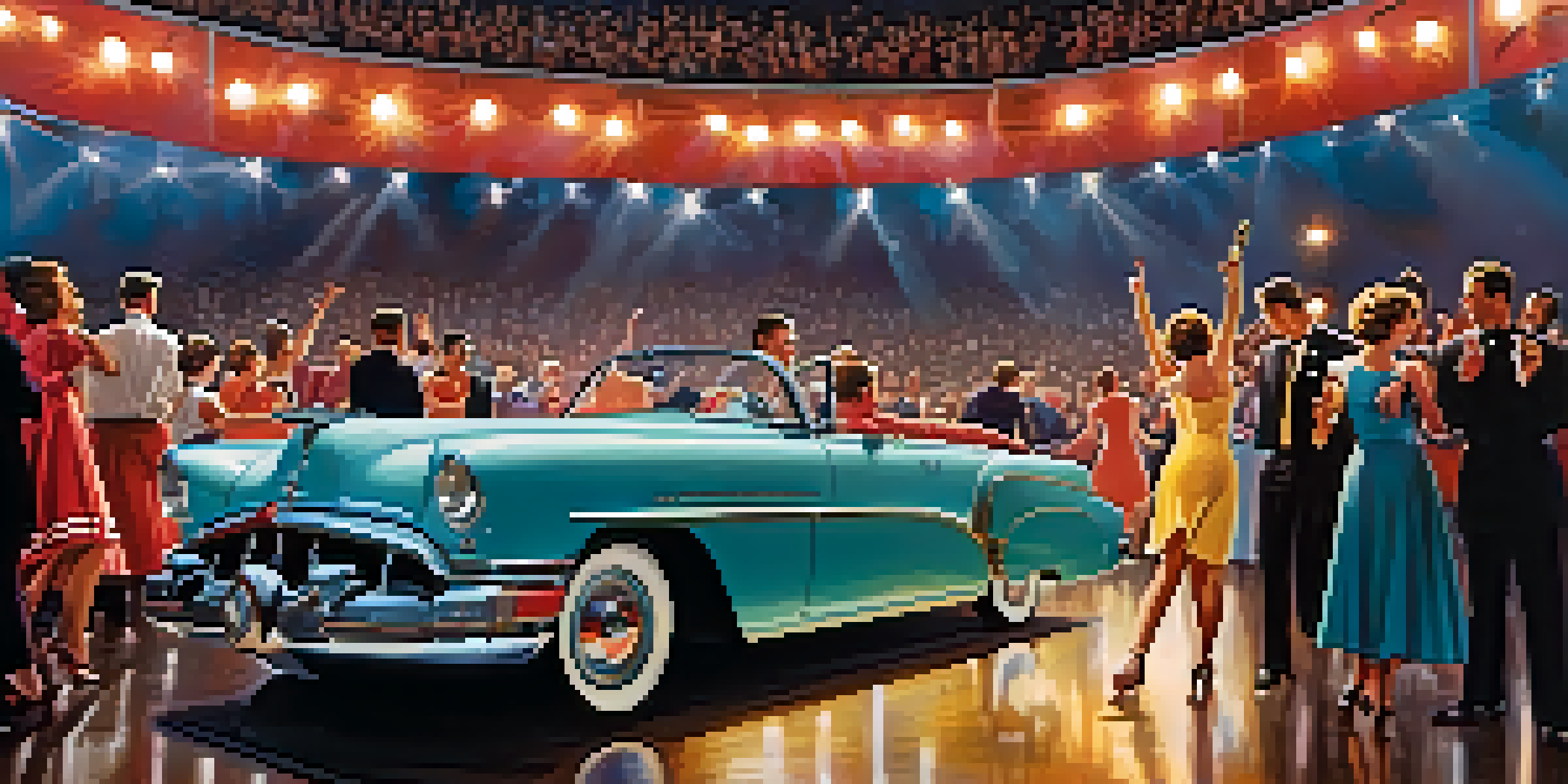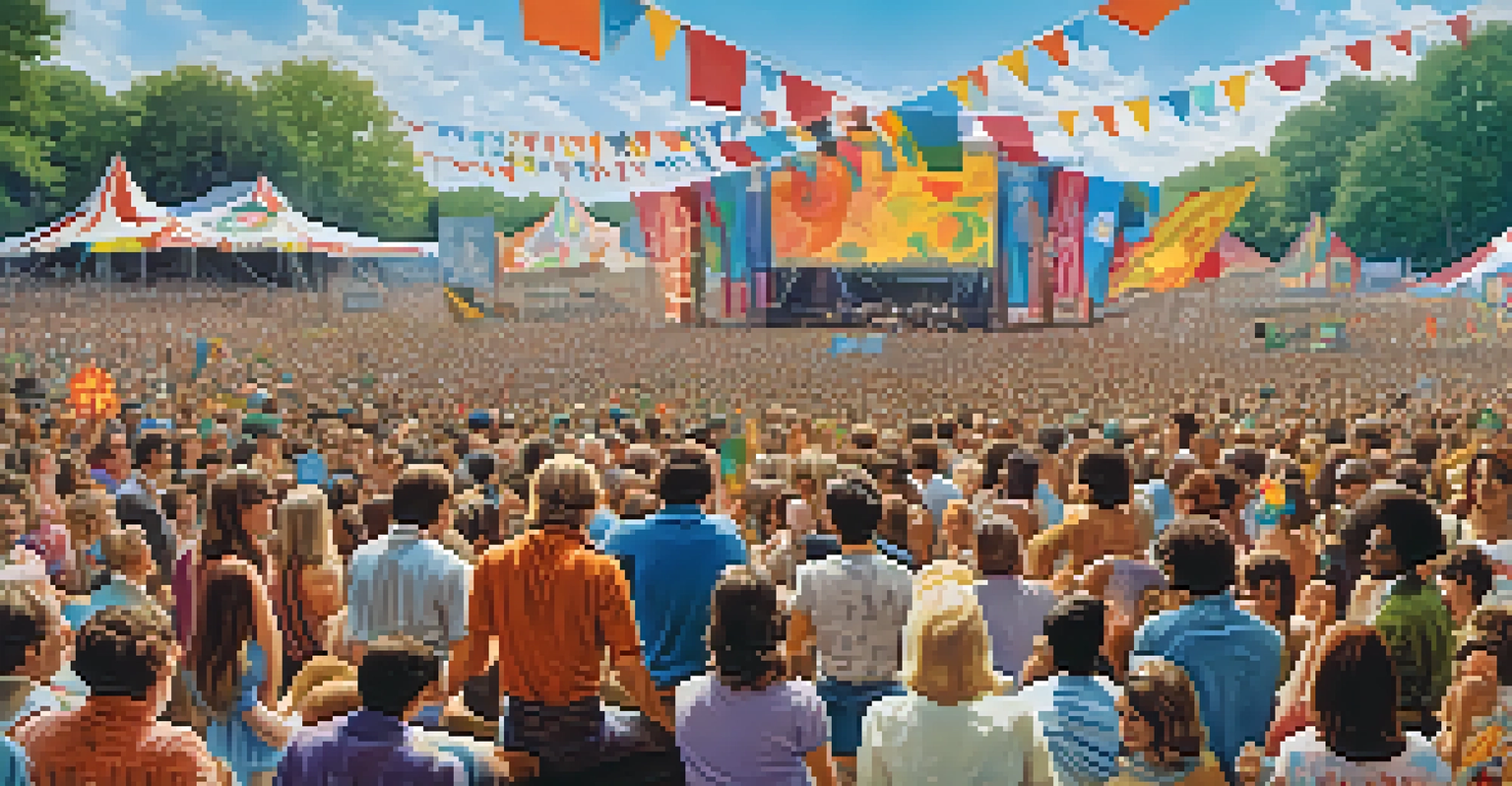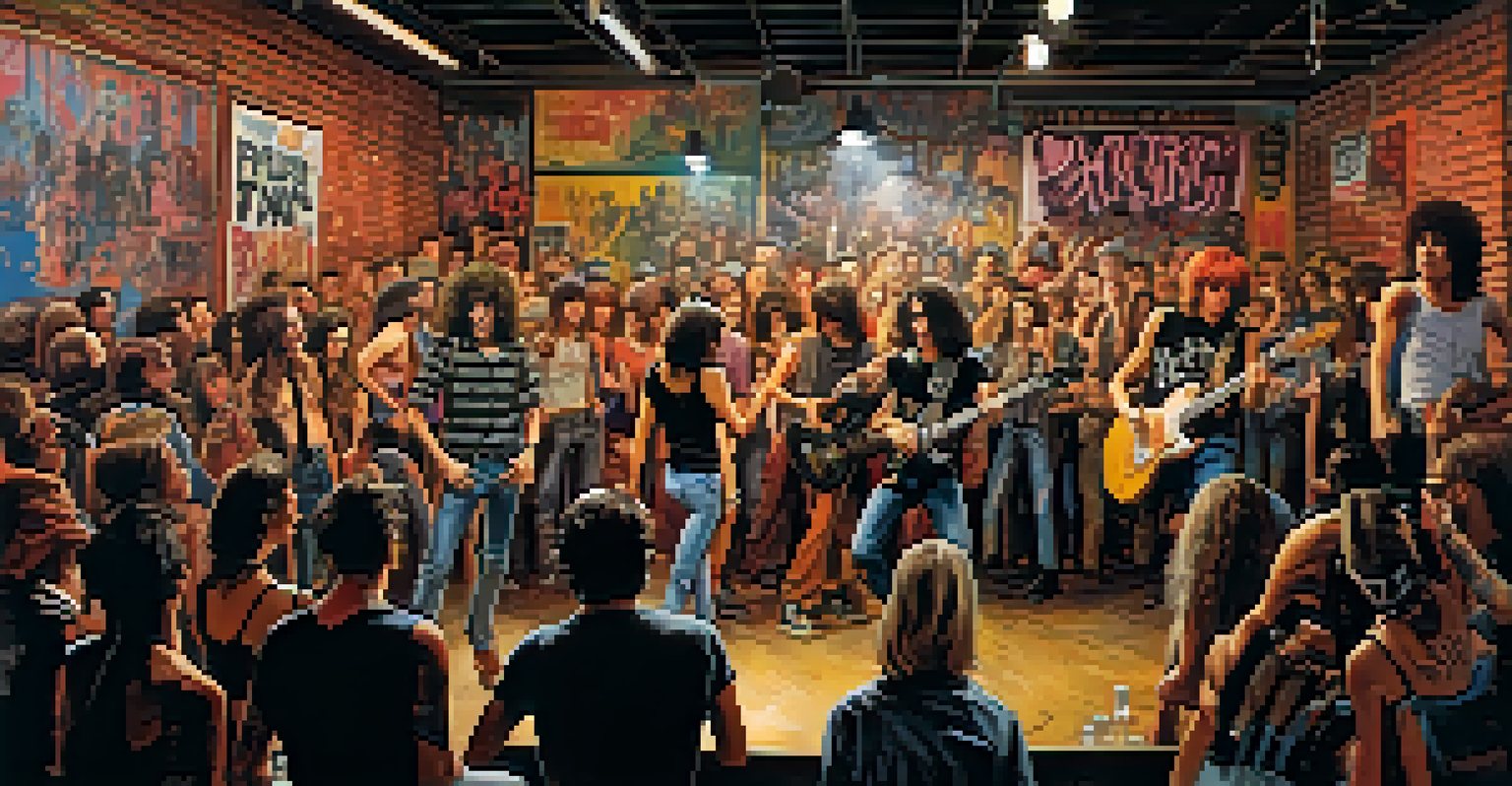Concerts That Define Genres: A Journey Through Music's Evolution

The Birth of Rock and Roll: The 1950s Revolution
In the 1950s, rock and roll emerged as a cultural phenomenon, fueled by groundbreaking concerts that defined the genre. One iconic event was Elvis Presley's performance on 'The Ed Sullivan Show' in 1956, which captivated millions and solidified rock's place in mainstream culture. This concert not only showcased Presley's electrifying stage presence but also marked a significant moment in music history, bridging racial divides with its fusion of rhythm and blues.
Music can change the world because it can change people.
The energy and excitement of these early performances drew in a diverse audience, transforming rock and roll into a unifying force. With artists like Chuck Berry and Little Richard setting the stage, concerts became a space for rebellion and youthful expression. This era laid the groundwork for future rock festivals, setting the tone for the genre's evolution.
As rock and roll gained traction, it sparked a wave of creativity that would influence countless musicians. The legacy of these defining concerts is still felt today, reminding us of the power of music to challenge norms and bring people together.
Woodstock: The Counterculture Movement of the 1960s
The Woodstock Festival of 1969 stands as a monumental event in music history, encapsulating the spirit of the 1960s counterculture. With performances from legends like Jimi Hendrix and Janis Joplin, the festival was more than just a concert; it was a statement of peace, love, and rebellion against societal norms. The iconic image of Hendrix performing 'The Star-Spangled Banner' became a symbol of protest and artistic expression.

Woodstock attracted over 400,000 attendees, showcasing the power of community and the unifying force of music. It also highlighted the growing influence of rock music as a voice for social change, addressing issues like war and civil rights. This festival laid the groundwork for future music festivals, emphasizing the importance of music as a catalyst for cultural change.
Rock and Roll Unites Generations
The rise of rock and roll in the 1950s showcased its ability to bridge cultural divides and create a unifying force among diverse audiences.
The legacy of Woodstock continues to resonate, inspiring generations of artists and fans alike. It serves as a reminder of music's ability to challenge the status quo and create a sense of belonging among diverse groups of people.
The Punk Rock Revolution: CBGB and Beyond
In the mid-1970s, the punk rock movement exploded onto the music scene, with CBGB in New York City becoming its epicenter. Bands like the Ramones and Blondie played pivotal roles in defining the genre, with their raw sound and anti-establishment ethos. These concerts were characterized by high energy, short songs, and a DIY attitude that resonated with disillusioned youth.
The power of music makes all the difference in the world.
Punk rock concerts were not just about the music; they embodied a lifestyle choice that rejected mainstream culture. The gritty atmosphere of venues like CBGB encouraged authentic expression and camaraderie among fans. This sense of belonging created a tight-knit community that valued individuality and artistic freedom.
The influence of punk rock continues to be felt in various music genres today, often inspiring new waves of artists. Its legacy reminds us that music can be a powerful tool for change, challenging societal norms and encouraging self-expression.
Hip-Hop’s Rise: The 1980s Block Parties
The 1980s marked a significant turning point for hip-hop, with block parties serving as the heartbeat of the culture. These events, often organized in urban neighborhoods, featured DJs spinning records and MCs showcasing their lyrical skills. The energy and creativity of these gatherings laid the foundation for what would become one of the most influential genres in music history.
Artists like Run-D.M.C. and Grandmaster Flash brought hip-hop to the mainstream, but it was the communal spirit of these block parties that truly defined the genre. They fostered a sense of identity and belonging among participants, celebrating creativity, dance, and self-expression. These concerts were not just entertainment; they were a form of social commentary and a platform for marginalized voices.
Woodstock: Music as Protest
The Woodstock Festival of 1969 highlighted the role of music in advocating for peace and social change during the counterculture movement.
As hip-hop continued to evolve, the legacy of these early concerts remained influential in shaping the genre's trajectory. They highlight the power of music as a means of storytelling and social engagement, inspiring future generations of artists.
The Grunge Era: Seattle's Music Scene Takes Center Stage
The early 1990s saw the rise of grunge, a genre that emerged from Seattle's underground music scene. With bands like Nirvana and Pearl Jam leading the charge, concerts became a means of expressing the angst and disillusionment of a generation. Nirvana's infamous performance at the 1992 MTV Video Music Awards introduced grunge to a global audience, showcasing its raw sound and emotional depth.
Grunge concerts fostered a sense of authenticity and rebellion, attracting fans who resonated with the genre's themes of alienation and societal critique. These performances often blurred the line between artist and audience, creating an intimate atmosphere that drew people together. The grunge movement challenged conventional norms, paving the way for alternative rock to flourish.
The impact of grunge on music and culture is undeniable, as it brought alternative sounds to the forefront. Its legacy continues to inspire artists today, reminding us of the importance of authenticity and self-expression in music.
The Pop-Punk Explosion: From Basement Shows to Arenas
The late 1990s and early 2000s witnessed the rise of pop-punk, a genre that blended the energy of punk rock with catchy melodies. Bands like Blink-182 and Green Day became household names, thanks in part to their high-energy concerts that captivated young audiences. The 1996 Warped Tour was a defining moment for pop-punk, showcasing a lineup of influential bands and creating a sense of community among fans.
These concerts became a platform for self-expression, tackling themes of adolescence, relationships, and rebellion. The accessibility of pop-punk made it relatable to a generation navigating the complexities of youth. Fans found solace in the lyrics and the vibrant atmosphere of live shows, fostering connections that transcended music.
Technology Shapes Future Concerts
Innovations like virtual reality are transforming live music experiences, ensuring that community and connection remain central to the concert experience.
The pop-punk movement continues to thrive, influencing new artists and genres. Its legacy is a testament to the power of music in shaping identities and creating lasting memories.
The Resurgence of Live Music: Festivals in the 2010s
The 2010s marked a resurgence of live music, with festivals like Coachella and Lollapalooza drawing massive crowds and showcasing diverse lineups. These events became cultural hubs where fans could experience a variety of genres and connect with artists. The festival scene emphasized the importance of live performances in an increasingly digital world, reminding us of the magic of shared experiences.
Concerts during this era often featured collaborations between artists from different genres, blurring the lines between musical styles. This fusion reflected a broader trend in music, where boundaries were pushed, and creativity flourished. Fans were not just spectators; they became part of an immersive experience, celebrating the power of music together.

The impact of these festivals continues to shape the music landscape, creating opportunities for emerging artists and fostering community. They remind us that live music has an unparalleled ability to bring people together, transcending differences and celebrating a shared love for music.
The Future of Concerts: Embracing Technology and Innovation
As we look to the future of concerts, technology is set to play a pivotal role in shaping the live music experience. Innovations such as virtual reality and augmented reality are transforming how fans engage with performances, allowing for immersive experiences that transcend physical boundaries. Artists are exploring new ways to connect with audiences, ensuring that the essence of live music remains vibrant.
The recent surge in livestream concerts during the pandemic demonstrated the adaptability of the music industry, proving that live music can thrive even in challenging times. This shift opened up opportunities for global audiences to experience concerts from the comfort of their homes, expanding the reach of artists and genres. The evolution of concert experiences continues to push creative boundaries, emphasizing inclusivity and accessibility.
Looking ahead, the future of concerts promises to be dynamic and ever-evolving. As technology continues to advance, the core of live music—community, expression, and connection—will remain at the forefront, ensuring that concerts continue to define and shape musical genres for years to come.